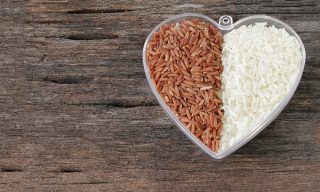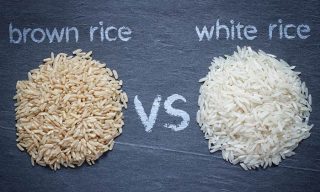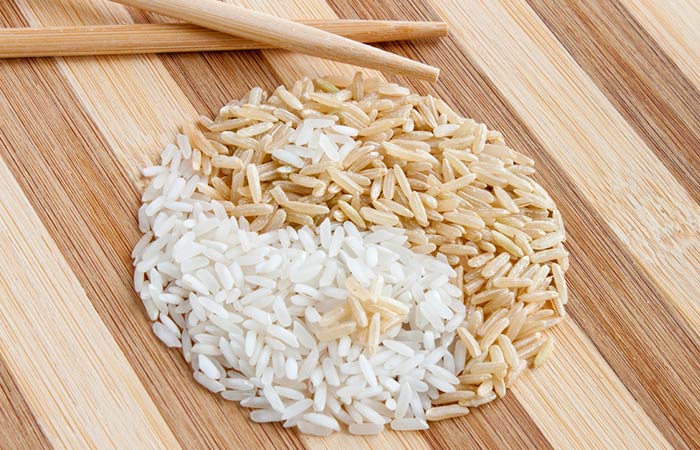This Japanese saying sits perfectly for the food item that feeds more than half of the world. No, the love for a bowl of perfect white rice isn’t limited to Asians, as widely assumed; it stretches to over three billion people from different sects, religions, and nations across the globe.
Most rice lovers don’t get satiated even after eating a piece of bread or roti unless they have eaten at least a morsel of rice. But with the world getting health conscious, the white rice is seen as a bitter enemy. Enter brown rice—the ‘healthy and pure’ form of rice—which took the world by storm. The authenticity and nutrition factor of white rice was (and is still) being questioned widely. Apparently, having the former will keep you fit and fine while the latter makes you unhealthy.
Want to know the truth? Let’s find out here brown rice vs white rice.
Difference Between White Rice And Brown Rice

Does brown rice deserve all the love?
Should we abandon white rice for the healthier choice?
What makes brown rice ‘healthier’?
Does it really matter?
Honestly, the whole hullabaloo about the perfect rice variety goes right above my head. Brown rice is brown rice, and white is white. Is brown rice better than white rice? Most today endorse brown rice. But if I don’t like the taste of it?
How different is brown rice from its white counterpart? To ease your mind and the process, I’ve noted down the difference in points. Scroll down to know in detail about brown rice vs white rice!
| Sl. No. | Brown Rice | White Rice |
| 1. | PHYSICAL PROPERTIESBrown rice is a whole grain. This means that it has all its part intact—the bran, germ, and the endosperm—only taking off the outer hull of the rice kernel. This also means it is high in nutrients, vitamins, and fiber.
The is the outer layer of the rice grain, and is full of antioxidants, fiber, and vitamin B. The middle layer, , is a rich source of essential proteins, some of the B vitamins, minerals, as well as healthy fats. The core, , contains carbohydrates, some proteins, and some of the vitamins and minerals. Brown rice is not stripped off any of these layers, which is both a blessing and a curse. How? For starters, with all these layers comes difficulties to digest them. Brown rice is hard to digest, owing to its high fiber content. It also has a very nutty flavor, that is not everyone’s cup of tea or ‘bowl of rice,’ honestly. Then comes the threat of phytic acid that is widely found in the bran layer. |
White rice, on the other hand, is made from stripping off the germ and bran, leaving only the endosperm intact. This variety is milled and heavily polished to give the white color to the core. So, as expected, most of the nutrients, proteins and the antioxidants are lost in the process, making white rice an ‘unhealthy option.’ So, in the general opinion, when you’re downing that tasty bowl of white rice with perfect side dishes, you’re missing out on most of the essential vitamins and minerals, antioxidants, folate, and fiber.But, this process also removes the bran layer, and thus eliminates the threat of phytic acid. Most importantly, white rice is easy to digest as the milling helps cut down the content of grain based fiber whose overdose can harm the gut, thus hampering the digestion process. |
| 2. | NUTRITION DENSITYOne cup of brown rice is believed to contain twice the amount of phosphorus and manganese (88 percent) like white rice. It also has two and half times the iron and three, four, and ten times the vitamin B3, vitamin B1, and vitamin B6, respectively. Just a portion of this variety fulfills almost 80 percent of the recommended daily requirement of manganese. This mineral is essential in the formation of good cholesterol, energy and sex hormone production. Brown rice also contains 27.3 percent (19.11 mcg) of selenium, 20.9 percent (83.85 mg) of magnesium, 83.85 mg of potassium and 18.7 tryptophan. That’s an impressive quantity, if we were, to be honest.
Even though the difference is quite small, brown rice contains more calories when compared to white rice. A bowl of cooked long grain brown rice contains about 216 calories to 206 of the white variety. But never forget that this type also comes with the curse that phytic acid is. This anti-nutrient is known for its effect on mineral absorption, impairing the absorption of essential minerals like iron, manganese, potassium, and magnesium (1, 2). |
White rice is pretty unlucky in this department. The milling and processing of grain to form white rice rips off around 6o percent of iron, 80 percent of vitamin B1, 90 percent of vitamin B6, 67 percent of vitamin B3, as well as almost half the manganese, phosphorus and dietary fiber that is naturally present in the grain.A cup of long grained white rice contains about 0.5 mg of manganese, 9.7 mcg of selenium, 8.7 mg of magnesium, 17.4 mg of potassium, and 206 calories.
The good thing here is that white rice is free of phytic acid, which saves all its mineral content. |
| 3. | DIABETESBrown rice is low on the glycemic index (GI) making it a better choice for people with diabetes.
A study conducted on overweight Asians concluded that those who had more brown rice than white witnessed a successful reduction in their blood glucose levels. It also leads to reduced resistance to insulin (3). But, this property is also dependent on the brown or white rice you are comparing to. On the GI scale of 0-100 with 100 being most susceptible to a glucose spike, and 0 being the least harmful, brown rice sits comfortably at 50 (4). This number looks like a king when you are weighing your options between this variety and white jasmine rice (79) or short grain white rice (89). But compare brown rice with white basmati rice and guess what! They are on the same level. |
With the high content of carbohydrates (remember the endosperm story?) white rice is known to have a higher glycemic index. This way it is quite harmful to the diabetics.If you are a white rice lover and can’t go without it even for a day, I suppose you can do better by cutting down on the portion or going for a low GI variety like white basmati rice. |
| 4. | WEIGHT LOSSBrown rice is believed to be a healthier option for those looking to shed some pounds. As explained earlier, this whole grain variety is packed with most of the essential vitamins, minerals, healthy fats, as well as proteins, which makes it incredibly heart friendly. It also has an impressive fiber content which helps facilitate proper bowel movement, thus aiding weight loss.
Being a whole grain variety, brown rice is well suited for people having uncontrolled hunger pangs. It makes you feel full for a long time, thus controlling your calorie intake. Apart from all this, brown rice is also known to improve healthy gut bacteria in your microbiome. The main downfall of this variety comes with its thick nature and somewhat unappealing taste. With so many layers hindering, brown rice is tough to digest. Also, phytic acid here interferes with the proper mineral absorption. So, there is no guarantee that you’ll get all the nutrients promised. |
Refined grains like white rice have forever been frowned upon due to their high carb and low fiber content. They might be limited in their nutrient content, but at least all of it is intact, unlike brown rice. They are almost phytic-acid free, can be easily digested, and most importantly, tasty.Additionally, the calories in white rice are fewer when compared to its counterpart, even though the difference is quite small.
All of this shows that white rice is not a bad option for weight watchers if the portion size is controlled. |
| 5. | DIGESTIBILITY FACTORIt is a given that brown rice, being nutrient and fiber-heavy, is not that easily digested. The main reason behind it is the presence of problematic middle layer bran which is home to all the fiber and phytic acid. | White rice, on the other hand, is a feasible digestive option. It has limited fiber content, and contains most of the nutrients, even though in a limited quantity. All of these factors make white rice variety superior for those with a weak digestive system. |
| 6. | ARSENIC CONTENTWith all the grain layers intact, brown rice contains a significant amount of arsenic, several folds more than its white variety. That’s why brown rice should not be eaten often or in an unlimited quantity. In fact, many of the brown rice brands have been reported to contain at least 50% more than the safe amount of arsenic, per cup, with several others exceeding the limit by two folds. (5)
So it’s a given that, even with its whole grain promises, intake of more than one serving of top quality brown rice will expose you to the toxic arsenic. Portion-controlling is the key here. It also shows that brown rice is not fit to be made a dietary staple. Long-term consumption of arsenic is known to increase the risk of chronic diseases such as cancer, Type II diabetes, and cardiovascular diseases (6, 7, 8). |
The ‘unhealthy’ white rice, especially the jasmine and basmati variety, is believed to contain the lowest levels of the toxic arsenic.Rinsing the rice is even better. Doing this will not only get rid of impurities but also helps in further reduction of the arsenic levels. |
| 7. | CARBOHYDRATE CONTENTBrown rice, while being all nutrient-dense, somewhat lacks in the healthy carb content. This proportion is highly overshadowed by the layers of fiber on the whole grain.
Though frowned upon, optimum carb content is essential for our body to function properly. It helps provide us with endless energy and is critical for keeping hormone production under control in women. |
White rice is ripped off all the additional layers and thus, has a better carb content.Just make sure you have superior white rice varieties, such as jasmine and basmati, in a limited manner to fulfill your carbohydrate requirements for the day. One cup of cooked long-grained white rice in a day is a reasonable quantity. |
| 8. | STRONGER TEETH AND BONESIf we go by the nutrient data available, brown rice is said to have about four times the magnesium as white rice. This shows that having brown rice occasionally can help maintain stronger teeth and bones. | Comparably, white rice falls short of minerals; Thus it is not a viable option for those wanting to strengthen their teeth and bones. |
| 9. | FAT CONTENTBoth the rice varieties have low on fat. But, brown rice contains a little higher amount of fat when compared to its sister variety.
A cup of brown rice contains about three grams of fat when compared to the one gram of fat in white rice. |
Is white rice fattening? White rice, though named ‘unhealthy and fattening’ contains lesser fat compared to its ‘heathier’ substitute. |
| 10. | FOLATE CONTENTIn the race to become healthier variety, this is another aspect where brown rice falls somewhat short.
While this variety is rich in essential B vitamins, it contains a comparably lesser amount of folate. This vitamin is absolutely necessary for women, particularly those who are pregnant or breastfeeding. |
White rice is an excellent source of folate. A cup of white rice contains about 95 micrograms of folate. This unhealthy counterpart of rice is not unhealthy after all. |
| 11. | ALLERGIESWith its heavy and rough texture, as well as the nutty taste, brown rice is more likely to cause allergies. It is known to aggravate leaky gut by tearing the stomach lining, which allows undigested food particles, bacteria, toxins, and other substances to enter the bloodstream.
So it is advised to look for allergic reactions before switching to a full-fledged meal of brown rice. |
White rice is particularly refined with a smooth texture and pleasant taste.It is easily digestible, contains most of the essential nutrients and is easily available.
So go for a bowl of white rice if you are allergic to its brown brother. |
Brown Rice Vs White Rice – The Verdict

As we just saw, the difference between white rice and brown rice is not much. But it is definitely clear that brown rice isn’t the purest of the variety, it has its own flaws. What matters most is the taste, your choice, and your budget.
Honestly, a cup of white rice won’t make you fat, like how a cup of brown rice won’t make you look better.
Always remember, nutrition is not a ‘one size fits all’ science—the degree of absorption and the effect varies from person to person. We all know that there are individuals who can eat everything and remain petite and, then there are those like me, prone to quick weight gain despite being on a strict diet. It’s all about your metabolism, really.
I always follow a mantra—‘Never have anything that doesn’t appease my taste buds no matter how healthy it is.’ Personally, I dislike the strong flavor of brown rice, so I prefer making white rice at home. While it was easy to get carried away by the very enticing debate over the ‘healthier rice option,’ I kept my ground.
My suggestion to you will be to remember these points next time you go grocery shopping:
- Eating rice is okay—whatever variety be it. Just keep the quantity in check. Not a fan of rice? It’s okay. But make sure you have a healthy source of carb in your diet that can substitute rice.
- White rice or brown rice—it’s totally up to you. The nutrients and the effects are almost the same. Let your taste buds be the judge. Just control the quantity and the frequency with brown rice.
- Weight watchers, keep in mind that your choice of rice variant is not going to make you gain weight unnecessarily. It’s the portion size that matters.
- Be smart, play with the varieties. Nature offers us plentiful choices, so it’s better that you play with it. Use basmati one day, and change to brown rice the next day. Do the same with long-grained and the short-grained variants. Make your meals enjoyable.
- Always remember that all the differences in calories, nutrients, and GI don’t matter because no person will have just a cup of rice, without an accompanying dish. It’s the overall meal that matters—rice alone is not going to make you fat or slim.
- As for those with diabetes, there is no way that you are going to have rice on an empty stomach, apart from the first meal of the day. It means that you are going to have it when your system already has some food in it. This further means that its effect on the blood glucose will be next to nothing. So brave up, and have your portion. Avoid having it first thing in the morning.
After carefully analyzing the pros and cons of both the rice varieties, it’s safe to conclude that while white and brown rice have their advantages, it doesn’t matter what you are having unless the portion-size is compromised. Be clear that, brown rice is not the king and white rice doesn’t deserve all the hate it gets. Both are almost similar—like apples and apples. In fact, several points favor white rice over the brown rice, like the phytic acid content, digestibility, and arsenic content.
This is all about brown rice vs white rice! So, we can say that none of them is ruling over the other. It’s a tie literally. Have the one you like, and do tell us which variety is your favorite! Write to us in the comment box below.





